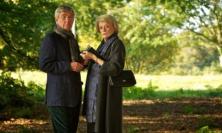Last year, Thinking Faith’s Lenten series explored ‘The Seven Deadly Sins on Film’; this year, we turn our attention to the cardinal and theological virtues. Catherine Hudak Klancer begins our quest to find ‘Virtues on Film’ by highlighting moving examples of all seven virtues – faith, hope, charity, prudence, temperance, fortitude and justice – in Peter Jackson’s epic production of J.R.R. Tolkien’s The Lord of the Rings.
Throughout the centuries, the Roman Catholic Church has trained, supported and promoted musicians, sculptors, painters and poets alongside philosophers and theologians. In so doing, it helped create a rich culture in which the concerns of one field of human study and expression have often become scope for exploration in another. The great medievalist C.S. Lewis calls our attention to this phenomenon in describing Dante Alighieri’s Divine Comedy as a Summa theologica in verse.[1] Like Saint Thomas Aquinas, Dante wished to enlighten his readers that they might better understand, and hence more deeply love, justice, order and truth.[2] That Dante believed his and other artistic media were suited for such a solemn and glorious project is clear in his claim that ‘art is the grandchild of God.’[3]
Dante was only one of many in the Catholic tradition to think in such terms. In the twentieth century, J.R.R. Tolkien conceived of his own literary inventions in a similar fashion, arguing that: ‘Fantasy remains a human right: we make in our measure and our derivative mode, because we are made: and not only made, but made in the image and likeness of a Maker.[4] In fact, he writes, ‘so great is the bounty with which [the Christian] has been treated that he may now, perhaps, fairly dare to guess that in Fantasy he may actually assist in the effoliation and multiple enrichment of creation.’[5] Tolkien goes so far as to dare to raise the possibility that his own sub-creations of humanity may someday spring out of the pages on which they are written: ‘all tales may come true.’[6]
Although Tolkien’s tales have yet to ‘come true’ in the fullest sense, they have certainly come to vivid life in the films of Peter Jackson. While a powerful case may be made for the beautiful sets and costumes of Jackson’s trilogy assisting in the aesthetic effoliation and enrichment of creation, this article looks at the ethical ways in which his production does so; in particular, by focusing on its portrayals of Christian morality.
Like other great religious and philosophical traditions, Christianity has traditionally recommended a whole host of virtues: humility, wisdom, loyalty, honesty and even amiability among them. Most important of all, from the Catholic perspective, are the four cardinal virtues also valued by the likes of Plato and Aristotle – fortitude, prudence, temperance and justice – and the three theological virtues perhaps most famously discussed in St. Paul’s Letter to the Corinthians – faith, hope and charity. While examples of fortitude are to be expected in blockbuster films with epic battle scenes, finding evidence of prudence and temperance in the same may seem more of a challenge. However, looking at the trilogy through the lens of Aquinas’s moral philosophy reveals signs not only of these calmer dispositions, but also of the explicitly theological virtues, and even guides the viewer to possibly new insights with regard to the true nature of courage.
The Cardinal Virtues
Unsurprisingly, we see a lot of fortitude in the form of willingness to face physical danger in The Lord of the Rings. This quality is exemplified most poignantly, perhaps, in the first film’s (The Fellowship of the Ring) portrayals of Gandalf and Boromir, and of Éowyn and Merry in the third (The Return of the King), all of whom fight terribly powerful and vicious foes in order to defend those they love. However, the Christian understanding of fortitude, defined by Aquinas as the virtue necessary to correct the will ‘disinclined to follow that which is in accordance with reason, on account of some difficulty that presents itself,’[7] while including military courage, is not limited to it. We see a different kind of bravery in Frodo and Sam, who have the far less dramatic task of remaining committed to putting one foot in front of the other. It is their fortitude in the face of tedium and weariness that brings the entire trilogy to its climax: Mordor’s destruction is ultimately due not to any glorious bravery on the battlefield, but rather to the success of their dreary, tiresome journey. Aquinas’s understanding of fortitude as being exemplified through martyrdom[8] is on display throughout the films in a particularly grim and drawn-out way, as Frodo walks on, and on, and on, refusing to turn back from what often seems to be certain death.
Such a quest is, on the face of it, hardly reasonable. We may find ourselves agreeing with Boromir when he makes an impassioned case in the first film for the suicidal imprudence of Frodo’s plan. After all, what chance has a hobbit – a small, weak, unheroic member of Middle Earth’s bourgeoisie – to triumph against the greatest powers of evil? However, when we look more closely at prudence, we find that it is not about what is easy, but rather what is right. As Aquinas tells us, ‘rectitude of choice requires two things: namely, the due end, and something suitably ordained to that due end.’[9] The virtue of prudence promotes not only desire of the right end, but also the ability to identify the best means to attain it. Crucially, and rather unfortunately for the possessor, neither means nor end may be in his own personal interest – a lesson Frodo learns repeatedly throughout the series. Given this understanding, the one who might seem most prudent – Boromir – is actually the least, as he is not aiming at the right end: destruction of the Ring. In fact, one might argue that, from a Christian perspective, this story is less heroic than prudent: Frodo is doing the best he can to achieve the goal identified as the correct one.
A similar argument may be made about temperance, a virtue of balance and harmony that seems to have little place in a world of violent and desperate choices. It turns out that, in Middle Earth, temperance shows itself in dramatic ways. The mirror opposite of fortitude, which helps those who don’t want to do the right thing, temperance helps those who want to do the wrong thing, particularly with regard to worldly desires for food, sex and power.[10] Its role in restraining the will is celebrated most starkly in the way it aids characters tempted by power. In the first film, Gandalf, Galadriel and Aragorn are all presented with the Ring, and, realising their own limitations and with varying degrees of struggle, they each refuse to take it. Their moral victory is clearer than ever when they are juxtaposed with other characters who fail such tests. Saruman, in particular, provides a sobering lesson on the salvific importance of temperance: giving way to his desire for power corrupts and, eventually, in the extended version of the third film, destroys him. In short, the films show us that the exercise of true virtue can look very different in different circumstances: a point Aquinas would agree with entirely.[11]
Finally, another hard case: if justice is a ‘habit whereby a man renders to each one his due,’[12] we do not see the characters exercising it toward Gollum. Gollum receives pardon consistently at the hands of those whom he would have made his enemies: Bilbo does not respond to Gollum’s threats of force with force of his own; Frodo does not kill him in self-defence; and even Sam, who openly despises him, exercises forbearance toward him. None of these characters is eager to deal out death in judgment, however such death may arguably be deserved. Nonetheless, by the end of the story, characters reap what they have sown, for both good and ill: Frodo is justly rewarded for his mercy to Gollum when the hobbit’s strength finally fails him at Mount Doom and he claims the Ring for his own. When Gollum then wrests the Ring from him and falls into the mountain’s fire, he not only finally receives his due,[13] but also saves Frodo from a similar fate, which the latter would not have deserved.
The Theological Virtues
When Gandalf tells Frodo to be wary of harsh judgment in the mines of Moria, he also reassures him: ‘there other forces at work in this world, Frodo, besides the will of evil.’ Is it their habit of justice that brings about the climax of the series?
The films remain tantalisingly silent on this issue: although we know that Gandalf ‘strayed out of thought and time’ after falling in Moria, we do not know who sent him back to Middle Earth to complete his task. Moreover, no one at any point in the trilogy expresses any expectation of being saved by divine forces, and no angels swoop down from heaven (although eagles do in the last battle before the gates of Mordor). Both dogma and worship are conspicuously absent from the trilogy.
Nonetheless, in a letter sent to a Jesuit friend, Tolkien said that Lord of the Rings ‘is of course a fundamentally religious and Catholic work.’[14] One way of interpreting this claim involves Saint Justin Martyr’s theory of logoi spermakoi (seeds of the word), or elements of divine truth that are present within all human philosophies and cultures, which can come to complete fulfillment only in Christianity. On the basis of this theory, we can look for seeds of the theological virtues in what Tom Shippey calls ‘a story of virtuous pagans in the darkest of dark pasts, before all but the faintest premonitions of dawn and revelation.’[15]
First, the trilogy as a whole is suffused by faith, defined by Aquinas (and the Bible) as ‘the substance of things to be hoped for, the evidence of things that appear not.’[16] Quests are by their nature exercises in faith – people do not go off in search of things that are right before them – and the central quest of Frodo and Sam is one among many in the films, including that of Boromir to find counsel at Rivendell, that of Aragorn, Gimli and Legolas to rescue Merry and Pippin, and that of Gandalf to find military aid for the Rohirrim in their time of need.
Success is not certain in any of these ventures, which is why the virtue of hope is necessary to engage in them: as Aquinas explains, the object of hope is ‘a future good, difficult but possible to obtain.’[17] The goods pursued by each member of the Fellowship are indeed difficult to obtain; so much so, that when Pippin asks Gandalf in the third film if there is any hope for Frodo and Sam, Gandalf answers, ‘there never was much hope. Just a fool’s hope.’ Regardless of its foolishness or scarcity, hope is a key element in the story, and the virtue behind one of the most moving scenes in the trilogy. At the end of the second film (The Two Towers), when Frodo is near to collapse, Sam tells him, ‘in the end, it’s only a passing thing, this Shadow... a new day will come, and when the sun shines, it will shine out the clearer.’ The strong friendship between the two hobbits enables Sam to share his hope for a better tomorrow with Frodo, who then finds the strength to keep going.
This friendship, at the very heart of the trilogy, is the epitome of the seed of the virtue of caritas: ‘charity’, or, as it is often translated into English, ‘love’. Christian doctrine states that charity is primarily but not solely directed toward God: Aquinas expresses the view of many when he explains that love of neighbour is intimately linked to love of God,[18] and underscores the this-worldly nature of charity with his admonitions that it must be expressed in loving action toward and on behalf of others, including but certainly not limited to giving money to people in need.[19] In the films, Sam provides a moving portrait of how Christians should devote themselves to others, showing both genuine love and the selfless service it entails as he follows Frodo into Mordor, and eventually physically carries him up the slope of Mount Doom.
The Saving Power of Love
As David H. Higgins explains, the Divine Comedy shows us that, ‘it is finally human love, not intellectual argument, that inspires Dante... Through Beatrice, Dante was able to love God, and even love him better.’[20] While the members of the Fellowship (Gandalf, perhaps, excepted) do not seem to have any relationship with powers beyond Middle Earth, they, too, find love more convincing than cold calculation. Unlike Saruman, who falls chiefly due to his over-reliance on his considerable powers of reason and deduction, Gandalf maintains his humanity through continuing to care for those who would be crushed in the event of the triumph of evil. Meanwhile, Boromir finds redemption in defending his comrades against insuperable foes, and Aragorn rededicates himself to his task when he learns that his beloved Arwen’s fate rests upon his doing so. We also see Pippin risk his own life to save Faramir’s, and watch Merry find the courage to fight when he has to do so for the sake of Éowyn; a more gradual process takes place between Gimli and Legolas, who overcome a historically troubled racial divide to become true friends. Above all, Sam’s love for Frodo, and Frodo’s for Sam, make the destruction of the Ring possible.
Tolkien’s narrative, realised in the wonderful performances of the actors in Jackson’s films, displays the saving power of charity and all its attendant virtues so beautifully as to give contemporary weight to Dante’s claim that art is the grandchild of God.
Catherine Hudak Klancer is a comparative theologian who focuses on ethics, authority and ritual practice in Christianity and Confucianism. She teaches at Boston College.
With thanks to Nicholas Austin SJ for his helpful comments on a preliminary draft of this article.
Bibliography
- Alighieri, Dante, The Divine Comedy, Translated by C.H. Sisson, Notes and introduction by David H. Higgins (Oxford, UK: Oxford University Press, 1998).
- Aquinas, Thomas, Summa theological, Fathers of the English Dominican Province, trans., Online Edition Copyright 2003 by Kevin Knight. Imprimatur + F. Beda Jarrett OP, S.T.L., A.M., Prior Provincialis Angliæ, http://www.newadvent.org/summa/
- Carpenter, Humphrey, ed., with the assistance of Christopher Tolkien, The Letters of J.R.R. Tolkien (Boston: Houghton Mifflin, 2000).
- Lewis, C.S., The Discarded Image: An Introduction to Medieval and Renaissance Literature (Cambridge, UK: Cambridge University Press, 1964).
- Shippey, Tom, The Road to Middle Earth: How J.R.R. Tolkien Created a New Mythology (Boston: Houghton Mifflin Company, 2003).
- Tolkien, J.R.R., The Tolkien Reader (New York: Ballantine Books, 1966).
[1] C.S. Lewis, The Discarded Image: An Introduction to Medieval and Renaissance Literature (Cambridge, UK: Cambridge University Press, 1964), pp. 10-11.
[2] For more discussion of the shared goals and perspectives of Aquinas and Dante, see David H. Higgins’ introduction to The Divine Comedy (Oxford, UK: Oxford University Press, 1998), pp. 21-23.
[3] Divine Comedy, Inferno XI, vv. 102-105.
[4] J.R.R. Tolkien, ‘On Fairy-Stories’, The Tolkien Reader (Ballantine Books: New York, 1966), p. 75 (emphasis added).
[5] Ibid., p. 89.
[6] Ibid., pp. 89-90.
[7] Summa theologica IIa IIae, q. 123, a. 3, resp.
[8] See IIa IIae q. 124.
[9] IIa IIae, q. 57, a. 3, ad. 2.
[10] See IIa IIae, q. 123, a. 3, resp.
[11] See, for example, IIa IIae, q. 141, a. 6, ad. 3.
[12] IIa IIae, q. 58, a. 1, resp.
[13] Of course, as the films make clear, Gollum has also been pushed beyond the limits of his endurance, and that it’s not his fault, but an unlucky chance – his mistreatment at the hands of Faramir’s men – that puts an end to the repentance and reform on which he had begun to embark. Bearing this in mind, one could argue that part of the justice of Gollum’s end is the way in which it takes place: he is punished, but swiftly.
[14] See Humphrey Carpenter, ed., with the assistance of Christopher Tolkien, The Letters of J.R.R. Tolkien (Boston: Houghton Mifflin, 200), p. 172.
[15] Tom Shippey, The Road to Middle Earth: How J.R.R. Tolkien Created a New Mythology (Boston: Houghton Mifflin Company, 2003), p. 199.
[16] IIa IIae, q. 4, a. 1; quoting Hebrews 11:1.
[17] IIa IIae, q. 17, a.1, resp.
[18] IIa IIae, q. 25, a. 1, resp.
[19] See IIa IIae, q. 32 for Aquinas’s discussion of almsgiving (eleemosyna),q. 33 for his treatment of fraternal correction (correctio fraterna), and q. 31for his analysis of beneficence (beneficentia), which he says ‘simply means doing good to someone’).
[20] Divine Comedy, 633.
‘Virtues on Film’ on Thinking Faith:
 Fortitude in Of Gods and Men by Niall Keenan
Fortitude in Of Gods and Men by Niall Keenan
 Prudence in Star Trek by Simon Potter
Prudence in Star Trek by Simon Potter
 Faith in High Noon by Karen Eliasen
Faith in High Noon by Karen Eliasen
 Justice in A Royal Affair by Nathan Koblintz
Justice in A Royal Affair by Nathan Koblintz
 Caritas in Quartet by Quentin de la Bédoyère
Caritas in Quartet by Quentin de la Bédoyère
 Hope in Life is Beautiful by Frances Murphy
Hope in Life is Beautiful by Frances Murphy
‘The Seven Deadly Sins on Film’ series on Thinking Faith:
 ‘The Seven Deadly Sins’ by Nicholas Austin SJ
‘The Seven Deadly Sins’ by Nicholas Austin SJ
 ‘Envy’ in Amadeus
‘Envy’ in Amadeus
 ‘Pride’ in The Talented Mr Ripley
‘Pride’ in The Talented Mr Ripley
 ‘Lust’ in Shame
‘Lust’ in Shame
 ‘Sloth’ in American Beauty
‘Sloth’ in American Beauty
 ‘Greed’ in Shallow Grave
‘Greed’ in Shallow Grave
 ‘Gluttony’ in Super Size Me
‘Gluttony’ in Super Size Me
 ‘Wrath’ in Shine
‘Wrath’ in Shine
![]() ‘The Hobbit: An unexpected theological journey’ by Alison Milbank
‘The Hobbit: An unexpected theological journey’ by Alison Milbank






